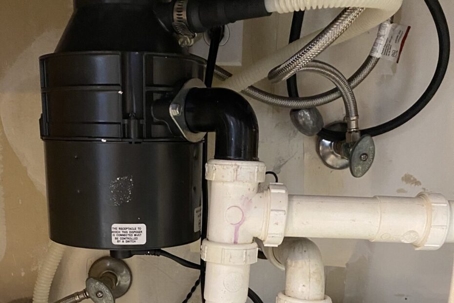Leading Methods for Resolving a Leak in Your Garbage Disposal
Leading Methods for Resolving a Leak in Your Garbage Disposal
Blog Article
What're your insights and beliefs on The Handy Guide To Fixing Your Garbage Disposal Leaking?

Garbage disposals are vital kitchen area appliances that assist in dealing with food waste efficiently. However, a dripping garbage disposal can be a frustrating and messy trouble to deal with. The good news is, many leakages can be dealt with conveniently with a couple of simple actions. In this short article, we will certainly talk about just how to take care of a leaking waste disposal unit effectively.
Intro
Waste disposal unit are installed under kitchen area sinks and are made to shred food waste into smaller items, permitting it to pass through the plumbing system quickly. While these gadgets are usually reputable, leaks can happen in time due to deterioration, loosened links, or damages to the unit.
Step-by-Step Overview to Fixing a Leaking Garbage Disposal
Turn Off the Power
Before attempting any kind of repairs, guarantee that the power to the waste disposal unit system is turned off to prevent the threat of electric shock.
Locate the Leakage
Identify the specific place of the leakage and figure out the cause
Tighten Links
Utilize a wrench to tighten any type of loose connections in between the disposal unit and the plumbing system.
Change Seals or Gaskets
If the leak is because of used seals or gaskets, remove the old elements and change them with brand-new ones.
Patching Cracks or Openings
For fractures or openings in the disposal unit, usage epoxy or a suitable patching material to secure the damaged area.
Recognizing the Source of the Leak
Prior to attempting to deal with a dripping garbage disposal, it is important to identify the resource of the leak. This can generally be done through visual assessment or by conducting easy examinations.
Visual Inspection
Inspect the waste disposal unit device carefully for any indicators of water leak. Pay attention to areas around seals, gaskets, and connection points.
Examining for Leakages
One means to test for leaks is by running water through the disposal unit and checking for any visible indicators of leakage.
Usual Root Causes Of Leakages in Garbage Disposals
Worn Seals and Gaskets
Seals and gaskets play a critical duty in stopping water from leaking out of the garbage disposal. Gradually, these elements can deteriorate, leading to leakages around the disposal system.
Loose Links
The connections in between the waste disposal unit and the pipes system can end up being loosened with time, triggering water to leak out throughout operation.
Fractures or Holes in the Disposal System
Physical damages to the waste disposal unit, such as cracks or holes in the housing, can additionally result in leaks.
Devices and Products Needed for Repairing a Leaking Waste Disposal Unit
Prior to beginning the repair work procedure, collect the necessary tools and materials, including a screwdriver, adjustable wrench, plumbing's putty, replacement seals or gaskets, and epoxy or patching material for repairing cracks or openings.
Testing the Garbage Disposal After Repair
When the repair is complete, test the garbage disposal by running water through it to make sure that the leakage has actually been solved.
Preventive Upkeep Tips to Stay Clear Of Future Leakages
To avoid future leakages, it is important to perform regular maintenance on your garbage disposal. This consists of keeping it clean, avoiding placing non-food things or hard objects down the disposal, and occasionally checking for leakages or various other concerns.
Verdict
Finally, repairing a leaking waste disposal unit is a relatively uncomplicated process that can be finished with standard tools and products. By adhering to the actions outlined in this article and practicing preventive upkeep, you can maintain your garbage disposal in good working problem and stay clear of costly repair services in the future.
HERE’S HOW TO FIX YOUR GARBAGE DISPOSAL
WHAT TO DO IF SOMETHING IS STUCK IN YOUR GARBAGE DISPOSAL
If the impeller won’t turn, there’s probably something stuck in the disposal. It could be a steak bone or peach pit, although plumbers report pulling all sorts of inappropriate objects out of disposals, such as bottle caps or aluminum foil. Make sure power to the disposal is off, and look inside to see if you can see the source of the jam.
Never stick your fingers in a disposal. Pull out anything you see with tongs or pliers.
If the disposal still won’t work, it may be time to call a plumber or consider buying a new disposal. GEM Plumbing & Heating is here for all of your garbage disposal needs.
WHAT TO DO IF YOUR GARBAGE DISPOSAL DRAIN IS CLOGGED
Take everything out from underneath your sink and put a bucket or other container under your disposal to catch any water that drains out. Disconnect your disposal from the power supply. If it’s plugged into a wall outlet, unplug it. If it’s hardwired into an electrical box, go to the electrical panel and turn off the breaker for the disposal. Pour ¼ cup of baking soda into the drain, followed by ½ cup of white vinegar. Give the solution a few minutes to fizz and do its work. Look into the disposal with a flashlight to see if you can see an object that might be causing the clog. If you see it, remove it using tongs or pliers. MORE TIPS ON DEALING WITH A CLOGGED GARBAGE DISPOSAL
Never use drain cleaner in a garbage disposal. It can damage the plastic parts inside the disposal. You can also be splashed with the caustic liquid while working to clear the clog. Beware! Never stick your fingers into a garbage disposal. Trust us — not a good idea. In many instances, your dishwasher drains through your garbage disposal. This allows the disposal to grind any large food particles that may be drained out of your dishwasher. There are some jurisdictions, however, where the plumbing code prohibits such a connection. WHAT TO DO WHEN YOUR DISHWASHER DRAINS THROUGH THE DISPOSAL
Run some water in the sink so your plunger has at least a ½-inch of water to create a seal and plunge vigorously up and down several times. You may need to repeat this several times. Run hot water down the drain to clear any residue that remains.

Hopefully you liked our part about Why Is . Thanks for taking a few minutes to read our blog. Enjoyed our write up? Please share it. Let others discover it. Thanks a bunch for your time. Kindly visit our site back soon.
Get Offer Report this page